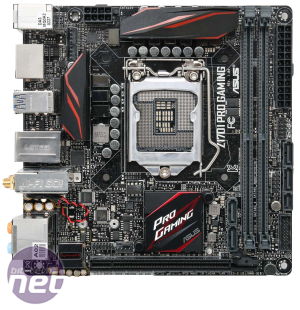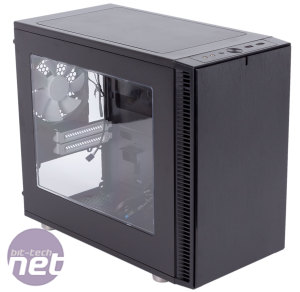
Pocket Rocket
Mini-ITX cases come in all shapes and sizes. Even among mini-ITX enthusiasts, we're never going to please everyone with this lineup – some want to prioritise making everything as small as possible, while others are happy simply with something smaller than your average mid-tower. Nonetheless, the components here are solid and will let you play games smoothly at 1080p, 1440p and in VR with an overall system footprint considerably less than most.| Product | UK price (inc VAT) | US price (ex tax) | |
| CPU | Intel Core i5-6600K | £220 | $225 |
| Motherboard | Asus Z170i Pro Gaming | £150 | $165 |
| Memory | 16GB (2 x 8GB) 3,000MHz DDR4 | £100 | $100 |
| Graphics card | Sapphire Radeon RX 480 Nitro+ OC 8GB | £245 | $270 |
| PSU | Corsair CS550M | £75 | $80 |
| CPU cooler | Cooler Master MasterLiquid Pro 240 | £95 | $115 |
| Storage | Crucial MX300 525GB M.2 SSD | £115 | $125 |
| Case | Fractal Design Define Nano S | £55 | $55 |
| Total price | £1,055 | $1,135 |
The specifications in many ways are similar to our Enthusiast Gamer system, which isn't surprising since the target gaming power is roughly the same. As such, we've again selected the Core i5-6600K, giving you four overclockable Skylake cores, and a dual-channel 16GB 3,000MHz DDR4 kit.
 The Asus Z170i Pro Gaming is our mini-ITX motherboard of choice. It's got plenty of features, a great layout and EFI and lots of overclocking potential. If you're not interested in overclocking (perhaps out of thermal concerns), then drop to a less expensive non-K edition CPU and a H170 motherboard to save cash.
The Asus Z170i Pro Gaming is our mini-ITX motherboard of choice. It's got plenty of features, a great layout and EFI and lots of overclocking potential. If you're not interested in overclocking (perhaps out of thermal concerns), then drop to a less expensive non-K edition CPU and a H170 motherboard to save cash.Our recommended graphics card is the same as the Enthusiast Gamer system – the Sapphire Radeon RX 480 Nitro+ OC 8GB, which is currently great for 1080p and VR play and would see you through a 1440p upgrade pretty well too. If 1440p is already your target, MSI's GTX 170 Gaming X again gets the nod. There are tiny mini-ITX GTX 1070 cards available, we know, but the reality is that most mini-ITX cases nowadays are designed with full-size or close to full-size cards in mind; honestly you could even install a GTX 1080 or Titan X in most of them if you really wanted. The ITX cards will be louder on account of their smaller coolers and are only really applicable to the very smallest of cases.
 It's the case that's really the key component of any mini-ITX build. Our choice of the Fractal Design Define Nano S is likely to be controversial for some given that it's one of the largest mini-ITX cases around (not forgetting the Manta, of course). However, it's got plenty of room for high-end hardware (including water-cooler gear) and is very easy to work with as a result, not to mention very competitively priced. Still, for those looking for something that really makes the most of the form factor, the Parvum X1.0 for £70 is a lovely choice. It requires assembly, but it looks awesome and is definitely on the compact side.
It's the case that's really the key component of any mini-ITX build. Our choice of the Fractal Design Define Nano S is likely to be controversial for some given that it's one of the largest mini-ITX cases around (not forgetting the Manta, of course). However, it's got plenty of room for high-end hardware (including water-cooler gear) and is very easy to work with as a result, not to mention very competitively priced. Still, for those looking for something that really makes the most of the form factor, the Parvum X1.0 for £70 is a lovely choice. It requires assembly, but it looks awesome and is definitely on the compact side.The Cooler Master all-in-one cooler will allow you to push your overclocking far and should have no trouble fitting inside the Fractal Design chassis. Meanwhile, if you choose the Parvum chassis instead, the Arctic Freezer i32 makes the most of the available space – it's said to be 150mm tall, which matches the maximum CPU cooler clearance of the Parvum case. If it doesn't quite fit you'll need to look at tower coolers with 92mm fans instead.
The Define Nano S houses ATX power supplies without issues so the Corsair CS550M from our Enthusiast Gamer build remains a stalwart choice. The Parvum chassis needs an SFX PSU, and we can wholeheartedly recommend the SilverStone SX600-G in that instance.
The 525GB Crucial MX300 M.2 SSD is no more expensive than the 2.5in version and is more suitable for a mini-ITX build, letting you make use of remaining hard drive or SSD mounts in future upgrades.

MSI MPG Velox 100R Chassis Review
October 14 2021 | 15:04








Want to comment? Please log in.